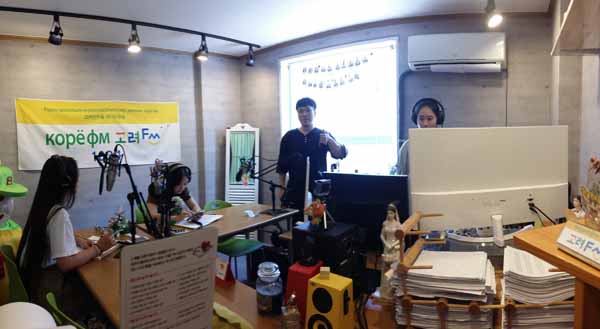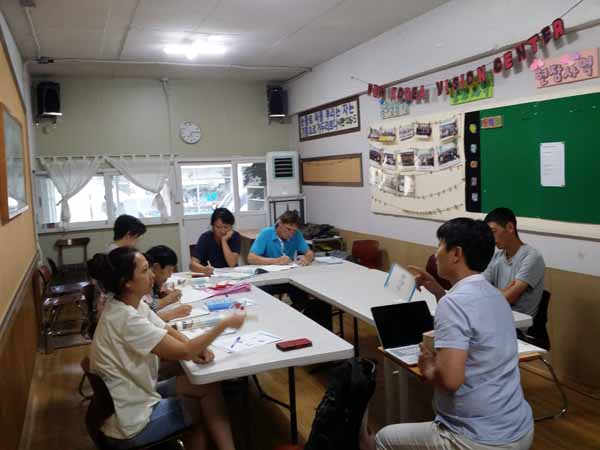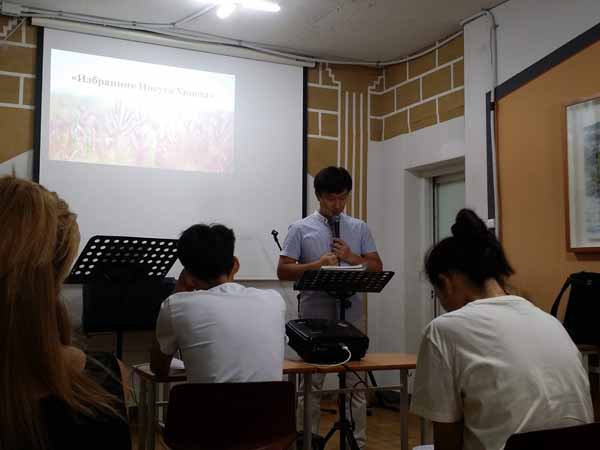Bridging Differences, Highlighting Humanities
광주 문화지도 제작 프로젝트:
차이를 연결하고, 인문학을 밝히다 <2>

Goryeo-in (고려인), translated into English as “Goryeo people,” refers to the Korean diaspora in Russia and Central Asian nations, including Uzbekistan, Tajikistan, and Kazakhstan. Due to hard times on the Korean Peninsula in the 1860s, Korean peasants staying near the Siberia-Korean border decided to migrate to the Maritime Province (Primorsky Krai) of Russia to look for a better life. During the Japanese occupation of the Korean Peninsula, Soviet dictator Joseph Stalin, who worried about the Japanese infiltration of Koreans staying in the Russian Far East, decided to forcefully deport them to Central Asia. According to some reports, around 36,000 families making up 170,000 people were deported. Life was difficult due to the totally different climate and environment there, but they managed to settle into a normal lifestyle within around three years. When the countries in Central Asia each declared independence following the collapse of the Soviet Union, the Goryeo-in in that region were then made citizens of several countries, with most being found within the borders of Russia, Uzbekistan, and Kazakhstan.
The beginning of the 21st century has seen the Korean diaspora slowly come back to the Korean Peninsula, mainly to Ansan, Gyeonggi Province, and Wolgok-dong in Gwangju. Both places were chosen mainly because of their proximity to industrial complexes that have a higher availability of jobs. Nevertheless, coming back to the motherland has not necessarily made for an easier life. Language barriers and misconceptions about their immigration status have resulted in many of them being treated like migrant workers, facing the same issues, such as the late payment of salaries.
As the project was conducted in the Goryeo-in community in Wolgok-2-dong, Gwangsan-gu, frequent visits to the neighborhood were warranted despite the faraway location. Our first visit to the Goryeo-in Village was filled with surprises for our eyes, ears, and taste buds. In the village, we saw people with Korean faces who did not speak Korean, but rather Russian or Uzbek. We visited the Goryeo-in Museum, which is housed in a residential location within the village. The museum also functions as a clinic on Tuesdays where volunteer doctors make visits to provide medical services to Goryeo-in who are unable to receive treatment at hospitals for whatever reason. Restaurants and supermarkets selling Russian and Central Asian food are seen around the village and frequented mostly by Goryeo-in who buy their daily necessities there. Our encounter with the local delicacies resulted in a totally different kind of taste from the Korean cuisine we were accustomed to, suggesting a great change had taken place during those 154 years away from the motherland.
Why the Project?
A simple search on Google or Naver results in tons of results for “Goryeo-in” in the form of news articles, SNS pages, videos, and so on. However, a survey done by our project team revealed that as many as 37 percent of our survey respondents, residents of Gwangju, had never heard about Goryeo-in, 58 percent had never heard about the Goryeo-in Village, and a whopping 97 percent had never been to the Goryeo-in Village. Such results confirm the necessity of such a project in order to increase the awareness of locals about their fellow countrymen and provide a great opportunity for foreigners to understand a forgotten piece of Korean history. We also hope that assistance and resources will become more readily available for this community, following the heightened awareness provided in part by this project.

Our project team is now working hard to produce a cultural map booklet detailing the history, stories, and culture of the Goryeo-in in both Korean and English. Team members are keeping up with the work despite their busy schedules. The project team has also received much help from passionate people providing us leads and contacts for information. This hard work and passion will hopefully pay off on September 8 when a walking tour in both Korean and English begins. Interested individuals are invited to join the walking tour by signing up on the Gwangju Cultural Mapping Project Facebook page or by scanning the QR code on this page.
Written and photographed by Lee Suk Pei
The Author
Suk Pei is currently studying for her master’s degree at Chonnam National University. Having been in Gwangju for almost one year, she is starting to extend her tentacles to meet different people and participate in various activities here in Gwangju. Gwangju is definitely more than what meets the eye.
*This article was originally published in Gwangju News September 2018 issue.
Gwangju News is the first public English monthly magazine in Korea, first published in 2001 by Gwangju International Center. Each monthly issue covers local and regional issues, with a focus on the stories and activities of the international residents and communities. Read our magazine online at: www.gwangjunewsgic.com
-<원문 해석>-
고려인 마을
고려인, 영어로 ‘고려사람’은 러시아와 우즈베키스탄, 타지키스탄, 카자흐스탄을 포함한 중앙아시아 국가들로 이주한 한국인을 일컫습니다. 1860년대 한반도의 어려운 시절로 인해, 시베리아와 한국 국경 인근에 거주하는 한국인 소작농들은 더 나은 삶을 위해 러시아 연해주(프리모르스키 지방)로 이동하기로 했습니다. 일제강점기 동안, 일본이 러시아의 극동 지역에 사는 한국인을 침략할 것을 우려한 소비에트 독재자 조셉 스탈린은 그들을 강제로 중앙아시아로 추방하기로 했습니다. 알려진 바에 의하면, 17만 명으로 구성된 3만6000가구가 추방되었습니다. 완전히 다른 기후와 환경 탓에 생활은 힘들었지만, 3년 정도 지나니 일상생활이 겨우 자리잡혔습니다. 소비에트 정권 붕괴에 따라 중앙아시아의 각 국가들이 독립을 선언할 때, 그 지역의 고려인들은 여러 나라로 나뉘어, 대부분 러시아의 국경과 우즈베키스탄, 카자흐스탄에서 시민이 되었습니다.
21세기가 시작되면서 한국인 이주민들이 서서히 한반도, 주로 경기도 안산, 광주 월곡동으로 돌아오는 것이 보였습니다. 두 지역들이 선택된 주요 이유는 일자리를 구할 확률이 높은 산업단지에 근접해 있기 때문입니다. 그럼에도, 모국으로 돌아가는 것이 반드시 쉬운 삶을 만들어 주는 것은 아닙니다. 언어의 장벽과 이민자 신분에 대한 오해는 그들 중 많은 이들이 외국인 노동자처럼 대우 받는 결과를 낳아, 임금체불 등과 같은 문제에 직면했습니다.

프로젝트가 광산구 월곡2동에 있는 고려인 지역사회에서 진행됨에 따라, 거리가 멀어도 자주 방문해야 했습니다. 고려인 마을의 첫 방문에 우리의 눈과 귀, 미각은 놀라움으로 가득찼습니다. 마을 안에서, 한국인의 얼굴이지만 한국말을 하지 않고 러시아어나 우즈벡 언어를 사용하는 사람들을 봤습니다. 우리는 마을 안의 주택가에 있는 고려인 박물관을 방문했습니다. 화요일에 그 박물관은 어떤 이유에서든 병원치료를 받지 못하는 고려인들에게 의료서비스를 봉사하러 방문하는 의사들의 진료소 기능도 했습니다. 러시아와 중앙아시아 음식을 파는 식당과 슈퍼마켓들이 주변에 보였고, 일상의 생필품을 사려는 고려인들로 붐볐습니다. 현지 음식은 우리가 익숙했던 한국 요리와는 전혀 다른 종류의 맛이었으며, 모국에서 떨어진 154년 동안 엄청난 변화가 있었음을 암시합니다.
왜 그 프로젝트인가?
구글이나 네이버에서 간단히 검색하면 ‘고려인’에 대한 뉴스기사, SNS페이지, 동영상 등 수 천 가지 검색 결과가 나옵니다. 하지만, 우리 팀의 설문조사에 의하면 응답자 중 광주 지역민 37%는 고려인에 대해 전혀 들어본 적이 없었으며, 58%는 고려인 마을에 대해 들어본 적이 없었고, 매우 큰 비중을 차지하는 97%는 고려인 마을에 방문해본 적이 없었습니다. 그 결과들이 같은 국민에 대한 지역민들의 인식을 증진시키고, 외국인들이 한국사의 잊혀진 부분을 이해할 수 있는 중대한 기회를 제공한다는 프로젝트의 필요성을 확인시켜 줍니다. 우리는 또한 이 프로젝트에서 부분적으로 제공한 높아진 인식으로 고려인 공동체를 위한 원조와 자원이 더 쉽게 이루어지기를 희망합니다.

우리는 지금 고려인의 역사, 이야기, 문화에 대한 세부화한 문화지도 소책자를 한국어와 영어로 만들기 위해 열심히 일하고 있습니다. 팀 구성원들은 바쁜 일정에도 불구하고 일을 계속하고 있습니다. 우리는 또한 정보를 제공하고 연락해 오는 열정적인 사람들로부터 많은 도움을 받고 있습니다. 이러한 노고와 열정은 도보여행이 한국어와 영어로 시작되는 9월8일에 보상받을거라고 희망합니다. 관심있는 분들은 광주 문화지도 프로젝트 페이스북 페이지 또는 이 페이지의 QR코드를 스캔하여 도보여행에 참여할 수 있습니다.
글·사진=이숙페이 (Lee Suk Pei)
번역=백지연 (광주국제교류센터 자원활동가)
저자
숙페이는 현재 전남대학교에서 석사과정 중입니다. 거의 1년 동안 광주에 거주하면서 색다른 사람들을 만나고 다양한 활동에 참여하기 위해 촉각을 넓히기 시작했습니다. 광주는 확실히 눈으로 보는 것 그 이상입니다.
*이 글은 광주뉴스 2018년 9월호에 실린 내용입니다.
광주뉴스는 광주국제교류센터가 2001년에 처음 발행한 대한민국 최초의 영문 대중월간지로, 지역민과 거주 외국인의 이야기, 활동, 지역사회의 이슈 등 다양한 내용을 다루고 있습니다. 광주국제교류센터 회원과 외국인 관련 기관에 무료로 배포되며, 온라인에서도 잡지를 볼 수 있습니다. (www.gwangjunewsgic.com)

